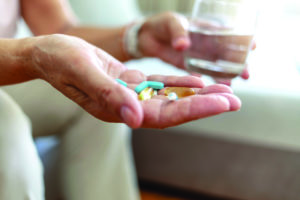 When people think about substance abuse and addiction, they often imagine young adults. While it’s true teenagers are at a higher risk for substance abuse as a group, research done on the elderly population is lacking. Despite the lack of research, it’s widely believed that substance abuse and addiction in the elderly is a hidden epidemic.
When people think about substance abuse and addiction, they often imagine young adults. While it’s true teenagers are at a higher risk for substance abuse as a group, research done on the elderly population is lacking. Despite the lack of research, it’s widely believed that substance abuse and addiction in the elderly is a hidden epidemic.
While no one wants to even imagine that their parents or grandparents may have problems with substance abuse or addiction (especially if they have no history), it’s essential to keep an eye out for these challenges. This article aims to help explain the importance of the issue, how to recognize the signs of use and abuse of different substances, and how to help.
Substance Abuse & Addiction Defined
There are many terms used to describe the use of drugs or alcohol. The shortest description is: “Substance abuse is a coping mechanism developed in response to triggers, while addiction is a disease involving chemical dependency.”
Those living with substance abuse generally have more control over the situation, often drinking or using drugs to deal with stress. They sometimes experience minimal disruption to their lives, but this should still be taken seriously because substance use or abuse of any level can exacerbate health problems — especially for seniors.
Those who are addicted to substances tend to have their lives overtaken by their conditions. They usually have a chemical need for alcohol or drugs and very little ability to stop themselves from partaking. It affects their daily lives and relationships are often damaged.
 Substance Abuse Disorder is a Health Crisis
Substance Abuse Disorder is a Health Crisis
There’s a common misconception that older adults don’t experience substance use disorder (SUD). However, a study revealed that nearly one million people over 65 were living with SUD.
As people age, their need for pain relief is likely to increase. But because opioids are highly addictive, they risk abuse of or addiction to the drugs.
Substances Commonly Abused by the Elderly
■ ALCOHOL: Alcohol is the most commonly abused substance. Alcohol abuse can be hard to recognize, leading many to call it a “hidden epidemic.” Part of the challenge is that signs of alcohol abuse are very similar to signs of aging. Nonetheless, here are some signs of alcohol abuse disorder:
• Frequent injuries
• Increased tolerance for other medications
• An overabundance of empty liquor bottles
• Displaying signs of cognitive impairment (e.g., forgetfulness, unsteadiness, confusion, memory loss, etc.)
• Slurred speech
• Symptoms of depression or anxiety
• Unpredictable mood swings
■ OPIOIDS: Synthetic opioids, such as oxycodone (Percocet and OxyContin), hydrocodone (Vicodin), codeine, morphine and fentanyl, are commonly prescribed for severe or chronic pain. With an estimated 65 percent of older adults suffering from pain and 30 percent reporting chronic pain, many could be prescribed opioids — which are highly addictive. Signs of opioid addiction:
• Hiding prescriptions
• Running out of opioid medications quickly
• Showing withdrawal symptoms (e.g., nausea, vomiting)
• Signs of cognitive impairment
• Using multiple pharmacies to fill prescriptions
■ BENZODIAZEPINES (BENZOS): Benzodiazepines, such as diazepam (Valium), lorazepam (Ativan), alprazolam (Xanax) and midazolam (Versed), are psychoactive relaxers that are commonly prescribed for people experiencing depression, anxiety, insomnia, muscle spasms or seizures (benzos are no longer recommended for treating insomnia in older adults because of the risk of Alzheimer’s). Signs of potential abuse include:
• Decreased attention span
• Drowsiness
• Memory loss
• Profuse sweating
• Running into objects or walls frequently (difficulty with spatial reasoning)
• Slurred speech
 ■ COCAINE: It may seem odd that cocaine is on a list of substances commonly abused by seniors. But aging baby boomers are changing the landscape of drug use — cocaine wasn’t a widely used in previous generations at the same age. Cocaine is popular because it makes many people feel great — at least for a little while. They may have increased self-confidence, euphoria and desire to be social — all things older adults may miss from their youth. With no prescriptions allowed — the only way users can get cocaine is through dealers. Some signs your loved one could be addicted to cocaine include:
■ COCAINE: It may seem odd that cocaine is on a list of substances commonly abused by seniors. But aging baby boomers are changing the landscape of drug use — cocaine wasn’t a widely used in previous generations at the same age. Cocaine is popular because it makes many people feel great — at least for a little while. They may have increased self-confidence, euphoria and desire to be social — all things older adults may miss from their youth. With no prescriptions allowed — the only way users can get cocaine is through dealers. Some signs your loved one could be addicted to cocaine include:
• Dilated pupils
• Excess energy and over-excitement
• Experiencing paranoia
• Little appetite
• Not sleeping
• Runny or red nose and sniffling often
■ MARIJUANA: Marijuana can be either smoked or ingested by being mixed with foods (edibles). Medical marijuana is commonly prescribed to older adults because it’s believed to help treat Alzheimer’s, cancer, glaucoma and pain, among other things that frequently affect this population. For states where it’s legal to sell and purchase, you can walk into a cannabis shop or dispensary. For states where the drug is illegal, regular users would likely purchase from a dealer. Some signs your loved one might have a marijuana dependency include:
• Consistently bloodshot eyes
• Decrease in coordination
• Lethargy and lack of motivation
• Loss of memory
• Using it every day or multiple times a day, especially if their doctors have recommended a lower frequency
■ HEROIN: People addicted to prescription opioids are often at risk of turning to heroin, especially if it gets too difficult to procure prescriptions. The drug can ease their pain the same way the opioids did. Heroin is usually acquired through a dealer. Signs of heroin use include:
• Constricted pupils
• Sleepiness while on it; inability to sleep when it wears off
• Slowed thoughts or movements
• Visible injection marks on their skin, often called “track marks”
• Pain, chills, vomiting, itchiness and nervousness when the heroin wears off
How to Help
Acknowledging there is a problem can be the first step to helping a loved one overcome addiction. Both caregivers and medical professionals can have important roles in getting assistance to someone suffering from SUD.
• Addiction Center: www.addictioncenter.com. Information on SUD and addiction, rehabilitation centers and other treatment options.
• National Institute on Drug Abuse: www.drugabuse.gov. Government resource provides answers to nearly every question you may have.
• Opioid Treatment Program Directory: dpt2.samhsa.gov/treatment. This directory helps you find opioid treatment in your state.
• RehabNet: https://rehabnet.com. Specifically designed for seniors living with drug and alcohol abuse or addiction. It provides a 24/7 hotline.
• SAMHSA National Helpline: www.samhsa.gov/find-help/national-helpline. This 24/7, confidential hotline is available to people living with or who care about someone with a substance use disorder. They can provide referrals to local assistance and send publications.
Find the full article at www.premiernursingacademy.org.


Leave a Reply